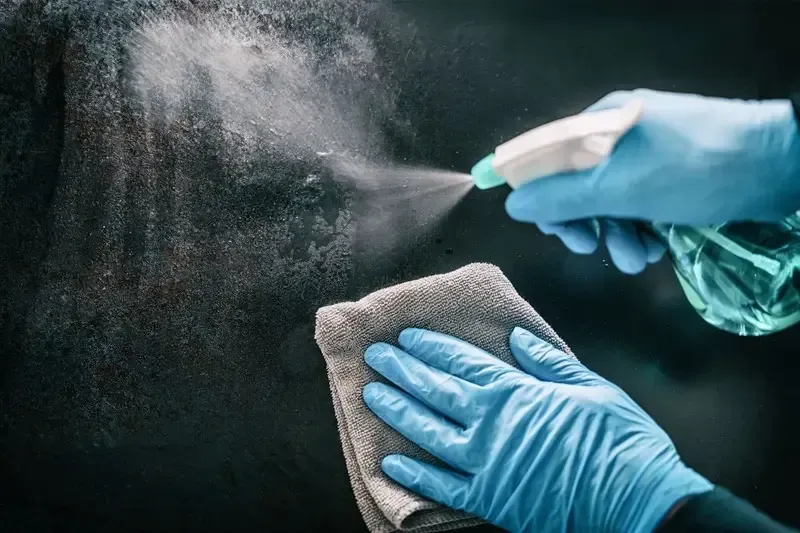Surface Protection Solutions Blog

Eco-Defense: The Future of Antimicrobial Protection in Hospitals
Introduction to Antimicrobial Protection in Hospitals
In an era where hospital-acquired infections pose a significant threat to patient safety, the role of antimicrobial protection cannot be overstated. Traditional methods in healthcare settings have primarily focused on using chemical-based disinfectants and coatings to prevent the spread of pathogens. However, with a growing emphasis on environmental sustainability and patient well-being, there is a shift towards exploring eco-friendly alternatives.
Eco-friendly antimicrobial surface protection represents a groundbreaking approach in this context. It’s not merely about combating pathogens; it’s also about doing so in a manner that’s harmonious with our environment. This approach aligns with the broader objectives of healthcare: to heal without causing harm, either to patients or the planet.
The move towards eco-friendly antimicrobial protection solutions in hospitals is driven by multiple factors. Increased awareness of the harmful effects of certain chemicals, a rising demand for sustainable healthcare practices, and the ongoing battle against antibiotic-resistant bacteria are significant motivators. Additionally, the environmental impact of traditional antimicrobial methods cannot be ignored, as they often involve toxic elements that can harm ecosystems.
This article, titled “Eco-Defense: The Future of Antimicrobial Protection in Hospitals”, delves into the innovative world of eco-friendly antimicrobial protection. We explore its rising popularity, the benefits it offers, the challenges it faces, and its potential to reshape the landscape of infection control in healthcare settings. The journey towards a safer, more sustainable future in healthcare begins with understanding and embracing these eco-conscious innovations.

The Rise of Eco-Friendly Solutions in Antimicrobial Protection
The healthcare sector is witnessing a paradigm shift in antimicrobial strategies, marked by an increasing adoption of eco-friendly solutions. This transition is rooted in a critical understanding that the health of patients and the planet are intrinsically linked.
Understanding the Need for Change
Traditional antimicrobial protection methods, while effective in curbing the spread of infections, often rely on chemicals that can be harmful to both human health and the environment. Overuse and improper disposal of these chemicals have led to concerns like antibiotic resistance and environmental pollution. Consequently, the healthcare industry is re-evaluating its approach, seeking solutions that offer protection without adverse side effects.
Innovations in Eco-Friendly Antimicrobials
In response to this need, recent years have seen remarkable innovations in eco-friendly antimicrobials. These include surfaces treated with natural antimicrobial agents, such as copper and silver, which possess inherent pathogen-resistant properties. Additionally, advancements in nanotechnology and biotechnology have paved the way for novel materials that can actively destroy harmful microbes without the need for harmful chemicals.
Regulatory Support and Industry Adoption
Encouragingly, these eco-friendly alternatives are gaining not only scientific validation but also regulatory support. Governments and health organisations across the globe are advocating for sustainable practices in healthcare settings, recognising the long-term benefits of such initiatives. This support is further bolstered by the healthcare industry’s willingness to adopt these innovative solutions, driven by a commitment to patient safety and environmental stewardship.
The Role of Education and Awareness
Central to the adoption of these eco-friendly antimicrobials is the role of education and awareness. Healthcare professionals, facility managers, and policymakers need to be informed about the benefits and applications of these alternatives. Educational initiatives and training programmes are crucial in ensuring that these solutions are correctly implemented and utilised to their full potential.
The Impact on Healthcare Practice
The adoption of eco-friendly antimicrobial solutions is transforming healthcare practices. Hospitals and clinics are not only becoming safer for patients but are also contributing to a healthier environment. This approach aligns with a broader vision of sustainable healthcare, where patient care and environmental care go hand in hand.
Benefits of Eco-Friendly Antimicrobial Surfaces
Eco-friendly antimicrobial protection surfaces are more than just a trend; they represent a significant advancement in hospital hygiene and patient safety. This section examines the myriad benefits these surfaces offer, reinforcing why they are increasingly favoured in healthcare settings.
Enhanced Patient Safety
One of the primary advantages of eco-friendly antimicrobial surfaces is the increased safety they provide to patients. By reducing the reliance on harsh chemicals and potent antibiotics, these surfaces minimise the risk of allergic reactions, chemical sensitivity, and the development of antibiotic-resistant strains of bacteria. The use of natural or less-toxic materials ensures a safer environment for patients, particularly those with compromised immune systems.
Environmental Impact
The environmental benefits of these surfaces are profound. Traditional antimicrobial agents often contain chemicals that can be toxic to wildlife and ecosystems when they enter waterways and soils. Eco-friendly alternatives, on the other hand, are designed to minimise environmental harm, aligning with the growing global emphasis on sustainable and responsible healthcare practices.
Long-Term Cost-Effectiveness
While the initial investment in eco-friendly antimicrobial surfaces may be higher than traditional options, they offer long-term cost-effectiveness. Their durability, reduced need for frequent replacement or maintenance, and the avoidance of costs associated with chemical-related health issues make them a financially viable choice in the long run.
Improved Public Perception
Hospitals adopting eco-friendly practices, including antimicrobial surfaces, benefit from an improved public image. In an era where consumers are increasingly conscious of environmental issues, hospitals that demonstrate a commitment to sustainability and patient safety can enhance their reputation, potentially attracting more patients and funding.
Compliance with Regulatory Standards
Finally, the use of eco-friendly antimicrobial surfaces helps hospitals stay ahead of regulatory curves. As governments and healthcare regulators increasingly advocate for sustainable practices, adopting these surfaces can ensure compliance with emerging environmental and safety standards, avoiding potential legal and financial repercussions.
Challenges and Considerations in Implementing Eco-Friendly Antimicrobial Protection Solutions
While the benefits of eco-friendly antimicrobial surfaces are clear, their implementation in hospital settings is not without challenges. Understanding and addressing these challenges is crucial for the successful integration of these solutions.
Balancing Cost and Practicality
One of the most significant challenges is balancing the cost and practicality of implementing eco-friendly solutions. While long-term benefits and cost savings are evident, the initial investment can be substantial. Hospitals must navigate budget constraints and justify the expenditure, especially when traditional methods are less expensive upfront.
Ensuring Effectiveness and Reliability
Another critical consideration is ensuring the effectiveness and reliability of these solutions. While eco-friendly antimicrobials are promising, they must meet the same stringent standards for infection control as traditional methods. Rigorous testing, certification, and continuous monitoring are essential to validate their effectiveness.
Training and Education
Implementing new technologies requires adequate training and education for healthcare staff. Ensuring that all personnel are knowledgeable about the proper use and maintenance of these surfaces is crucial for their effectiveness. This involves investment in training programs and ongoing support.
Overcoming Resistance to Change
Resistance to change can be a significant barrier in the healthcare industry, known for its adherence to established practices. Convincing stakeholders, from management to frontline workers, about the benefits of switching to eco-friendly options requires a strategic approach, emphasising not just the environmental benefits but also the health and safety advantages.
Navigating Regulatory Landscapes
Finally, hospitals must navigate complex regulatory landscapes when implementing these solutions. Regulations regarding hospital hygiene and safety can vary significantly, and keeping abreast of the latest standards and ensuring compliance can be challenging.
Case Studies and Future Outlook of Eco-Friendly Antimicrobial Protection in Healthcare
This section highlights real-world applications of eco-friendly antimicrobial surfaces and discusses their potential future impact on hospital hygiene and patient safety.
Real-World Success Stories
Across the UK and globally, numerous healthcare facilities have successfully implemented eco-friendly antimicrobial protection solutions. For instance, a hospital in London reported a significant reduction in hospital-acquired infections after installing copper-based antimicrobial surfaces. These real-world examples provide tangible evidence of the effectiveness and feasibility of these solutions.
Innovations on the Horizon
The future of eco-friendly antimicrobial surfaces looks promising, with ongoing research and development. Innovations like self-cleaning surfaces, advanced biodegradable materials, and smart surfaces that can detect and respond to microbial contamination are on the horizon. These advancements could further revolutionise infection control in healthcare settings.
Integrating Technology and Healthcare
The integration of technology in healthcare is set to play a pivotal role in the advancement of eco-friendly antimicrobial solutions. Leveraging data analytics, IoT, and AI to monitor and manage these surfaces can enhance their effectiveness and efficiency, providing real-time insights and proactive infection control measures.
Scaling Up for Global Impact
While initial adoption has been promising, scaling up these solutions for global impact remains a challenge. Collaborative efforts between governments, healthcare institutions, and technology providers are necessary to make these solutions accessible and affordable for healthcare facilities worldwide, regardless of their size or location.
Shaping the Future of Hospital Hygiene
Ultimately, the continued development and adoption of eco-friendly antimicrobial surfaces have the potential to shape the future of hospital hygiene. As these solutions become more prevalent and advanced, they can lead to a new standard in healthcare: one that prioritises patient safety, environmental sustainability, and innovative infection control strategies.
Conclusion
“Eco-Defense: The Future of Antimicrobial Protection in Hospitals” has taken us on a journey through the transformative world of eco-friendly antimicrobial protection. From understanding the imperative for change in hospital hygiene practices to exploring the innovative solutions at the forefront of this shift, it’s clear that eco-friendly antimicrobial surfaces are more than just a fleeting trend — they are a vital component in the future of healthcare.
The benefits of these solutions extend beyond patient safety and environmental sustainability. They represent a new ethos in healthcare — one that harmonises patient care with planetary care. The challenges in implementing these solutions, while significant, are surmountable with strategic planning, stakeholder engagement, and a commitment to innovation.
Looking ahead, the potential of eco-friendly antimicrobial surfaces in revolutionising hospital hygiene is immense. As we witness advancements in technology and a growing emphasis on sustainable healthcare practices, these solutions are set to become an integral part of hospitals worldwide. The shift towards eco-friendly antimicrobial protection is not just a step forward in infection control; it’s a leap towards a healthier, more sustainable future for all.

Eco-Defense: The Future of Antimicrobial Protection in Hospitals
Introduction to Antimicrobial Protection in Hospitals
In an era where hospital-acquired infections pose a significant threat to patient safety, the role of antimicrobial protection cannot be overstated. Traditional methods in healthcare settings have primarily focused on using chemical-based disinfectants and coatings to prevent the spread of pathogens. However, with a growing emphasis on environmental sustainability and patient well-being, there is a shift towards exploring eco-friendly alternatives.
Eco-friendly antimicrobial surface protection represents a groundbreaking approach in this context. It’s not merely about combating pathogens; it’s also about doing so in a manner that’s harmonious with our environment. This approach aligns with the broader objectives of healthcare: to heal without causing harm, either to patients or the planet.
The move towards eco-friendly antimicrobial protection solutions in hospitals is driven by multiple factors. Increased awareness of the harmful effects of certain chemicals, a rising demand for sustainable healthcare practices, and the ongoing battle against antibiotic-resistant bacteria are significant motivators. Additionally, the environmental impact of traditional antimicrobial methods cannot be ignored, as they often involve toxic elements that can harm ecosystems.
This article, titled “Eco-Defense: The Future of Antimicrobial Protection in Hospitals”, delves into the innovative world of eco-friendly antimicrobial protection. We explore its rising popularity, the benefits it offers, the challenges it faces, and its potential to reshape the landscape of infection control in healthcare settings. The journey towards a safer, more sustainable future in healthcare begins with understanding and embracing these eco-conscious innovations.

The Rise of Eco-Friendly Solutions in Antimicrobial Protection
The healthcare sector is witnessing a paradigm shift in antimicrobial strategies, marked by an increasing adoption of eco-friendly solutions. This transition is rooted in a critical understanding that the health of patients and the planet are intrinsically linked.
Understanding the Need for Change
Traditional antimicrobial protection methods, while effective in curbing the spread of infections, often rely on chemicals that can be harmful to both human health and the environment. Overuse and improper disposal of these chemicals have led to concerns like antibiotic resistance and environmental pollution. Consequently, the healthcare industry is re-evaluating its approach, seeking solutions that offer protection without adverse side effects.
Innovations in Eco-Friendly Antimicrobials
In response to this need, recent years have seen remarkable innovations in eco-friendly antimicrobials. These include surfaces treated with natural antimicrobial agents, such as copper and silver, which possess inherent pathogen-resistant properties. Additionally, advancements in nanotechnology and biotechnology have paved the way for novel materials that can actively destroy harmful microbes without the need for harmful chemicals.
Regulatory Support and Industry Adoption
Encouragingly, these eco-friendly alternatives are gaining not only scientific validation but also regulatory support. Governments and health organisations across the globe are advocating for sustainable practices in healthcare settings, recognising the long-term benefits of such initiatives. This support is further bolstered by the healthcare industry’s willingness to adopt these innovative solutions, driven by a commitment to patient safety and environmental stewardship.
The Role of Education and Awareness
Central to the adoption of these eco-friendly antimicrobials is the role of education and awareness. Healthcare professionals, facility managers, and policymakers need to be informed about the benefits and applications of these alternatives. Educational initiatives and training programmes are crucial in ensuring that these solutions are correctly implemented and utilised to their full potential.
The Impact on Healthcare Practice
The adoption of eco-friendly antimicrobial solutions is transforming healthcare practices. Hospitals and clinics are not only becoming safer for patients but are also contributing to a healthier environment. This approach aligns with a broader vision of sustainable healthcare, where patient care and environmental care go hand in hand.
Benefits of Eco-Friendly Antimicrobial Surfaces
Eco-friendly antimicrobial protection surfaces are more than just a trend; they represent a significant advancement in hospital hygiene and patient safety. This section examines the myriad benefits these surfaces offer, reinforcing why they are increasingly favoured in healthcare settings.
Enhanced Patient Safety
One of the primary advantages of eco-friendly antimicrobial surfaces is the increased safety they provide to patients. By reducing the reliance on harsh chemicals and potent antibiotics, these surfaces minimise the risk of allergic reactions, chemical sensitivity, and the development of antibiotic-resistant strains of bacteria. The use of natural or less-toxic materials ensures a safer environment for patients, particularly those with compromised immune systems.
Environmental Impact
The environmental benefits of these surfaces are profound. Traditional antimicrobial agents often contain chemicals that can be toxic to wildlife and ecosystems when they enter waterways and soils. Eco-friendly alternatives, on the other hand, are designed to minimise environmental harm, aligning with the growing global emphasis on sustainable and responsible healthcare practices.
Long-Term Cost-Effectiveness
While the initial investment in eco-friendly antimicrobial surfaces may be higher than traditional options, they offer long-term cost-effectiveness. Their durability, reduced need for frequent replacement or maintenance, and the avoidance of costs associated with chemical-related health issues make them a financially viable choice in the long run.
Improved Public Perception
Hospitals adopting eco-friendly practices, including antimicrobial surfaces, benefit from an improved public image. In an era where consumers are increasingly conscious of environmental issues, hospitals that demonstrate a commitment to sustainability and patient safety can enhance their reputation, potentially attracting more patients and funding.
Compliance with Regulatory Standards
Finally, the use of eco-friendly antimicrobial surfaces helps hospitals stay ahead of regulatory curves. As governments and healthcare regulators increasingly advocate for sustainable practices, adopting these surfaces can ensure compliance with emerging environmental and safety standards, avoiding potential legal and financial repercussions.
Challenges and Considerations in Implementing Eco-Friendly Antimicrobial Protection Solutions
While the benefits of eco-friendly antimicrobial surfaces are clear, their implementation in hospital settings is not without challenges. Understanding and addressing these challenges is crucial for the successful integration of these solutions.
Balancing Cost and Practicality
One of the most significant challenges is balancing the cost and practicality of implementing eco-friendly solutions. While long-term benefits and cost savings are evident, the initial investment can be substantial. Hospitals must navigate budget constraints and justify the expenditure, especially when traditional methods are less expensive upfront.
Ensuring Effectiveness and Reliability
Another critical consideration is ensuring the effectiveness and reliability of these solutions. While eco-friendly antimicrobials are promising, they must meet the same stringent standards for infection control as traditional methods. Rigorous testing, certification, and continuous monitoring are essential to validate their effectiveness.
Training and Education
Implementing new technologies requires adequate training and education for healthcare staff. Ensuring that all personnel are knowledgeable about the proper use and maintenance of these surfaces is crucial for their effectiveness. This involves investment in training programs and ongoing support.
Overcoming Resistance to Change
Resistance to change can be a significant barrier in the healthcare industry, known for its adherence to established practices. Convincing stakeholders, from management to frontline workers, about the benefits of switching to eco-friendly options requires a strategic approach, emphasising not just the environmental benefits but also the health and safety advantages.
Navigating Regulatory Landscapes
Finally, hospitals must navigate complex regulatory landscapes when implementing these solutions. Regulations regarding hospital hygiene and safety can vary significantly, and keeping abreast of the latest standards and ensuring compliance can be challenging.
Case Studies and Future Outlook of Eco-Friendly Antimicrobial Protection in Healthcare
This section highlights real-world applications of eco-friendly antimicrobial surfaces and discusses their potential future impact on hospital hygiene and patient safety.
Real-World Success Stories
Across the UK and globally, numerous healthcare facilities have successfully implemented eco-friendly antimicrobial protection solutions. For instance, a hospital in London reported a significant reduction in hospital-acquired infections after installing copper-based antimicrobial surfaces. These real-world examples provide tangible evidence of the effectiveness and feasibility of these solutions.
Innovations on the Horizon
The future of eco-friendly antimicrobial surfaces looks promising, with ongoing research and development. Innovations like self-cleaning surfaces, advanced biodegradable materials, and smart surfaces that can detect and respond to microbial contamination are on the horizon. These advancements could further revolutionise infection control in healthcare settings.
Integrating Technology and Healthcare
The integration of technology in healthcare is set to play a pivotal role in the advancement of eco-friendly antimicrobial solutions. Leveraging data analytics, IoT, and AI to monitor and manage these surfaces can enhance their effectiveness and efficiency, providing real-time insights and proactive infection control measures.
Scaling Up for Global Impact
While initial adoption has been promising, scaling up these solutions for global impact remains a challenge. Collaborative efforts between governments, healthcare institutions, and technology providers are necessary to make these solutions accessible and affordable for healthcare facilities worldwide, regardless of their size or location.
Shaping the Future of Hospital Hygiene
Ultimately, the continued development and adoption of eco-friendly antimicrobial surfaces have the potential to shape the future of hospital hygiene. As these solutions become more prevalent and advanced, they can lead to a new standard in healthcare: one that prioritises patient safety, environmental sustainability, and innovative infection control strategies.
Conclusion
“Eco-Defense: The Future of Antimicrobial Protection in Hospitals” has taken us on a journey through the transformative world of eco-friendly antimicrobial protection. From understanding the imperative for change in hospital hygiene practices to exploring the innovative solutions at the forefront of this shift, it’s clear that eco-friendly antimicrobial surfaces are more than just a fleeting trend — they are a vital component in the future of healthcare.
The benefits of these solutions extend beyond patient safety and environmental sustainability. They represent a new ethos in healthcare — one that harmonises patient care with planetary care. The challenges in implementing these solutions, while significant, are surmountable with strategic planning, stakeholder engagement, and a commitment to innovation.
Looking ahead, the potential of eco-friendly antimicrobial surfaces in revolutionising hospital hygiene is immense. As we witness advancements in technology and a growing emphasis on sustainable healthcare practices, these solutions are set to become an integral part of hospitals worldwide. The shift towards eco-friendly antimicrobial protection is not just a step forward in infection control; it’s a leap towards a healthier, more sustainable future for all.
Delivering Tailored Solutions to Meet All Your Requirements
We’re excited to share more about how our innovative surface protection solutions can benefit you and your organisation. Please fill out this form with your details, and let us know any specific areas you’re interested in. Our team is dedicated to providing personalised information and will get back to you promptly with tailored insights and answers to your queries. Let’s start a conversation about bringing our superior surface protection to your space!
Get in Touch with Us
We’re excited to share more about how our innovative surface protection solutions can benefit you and your organisation. Please fill out this form with your details, and let us know any specific areas you’re interested in. Our team is dedicated to providing personalised information and will get back to you promptly with tailored insights and answers to your queries. Let’s start a conversation about bringing our superior surface protection to your space!
Sunshine Coast, Queensland
Monday - Friday, 8:00 am - 5:00 pm
Please Let Us Know Your Request
*Please select your appropriate requests
Industries
Follow Us
Surface Protection Solutions implement a sustainable surface protection program that reduces costs, increases customer satisfaction and promotes consumer confidence.
Surface Protection Solutions
© Copyright 2024 | All rights reserved.







